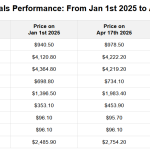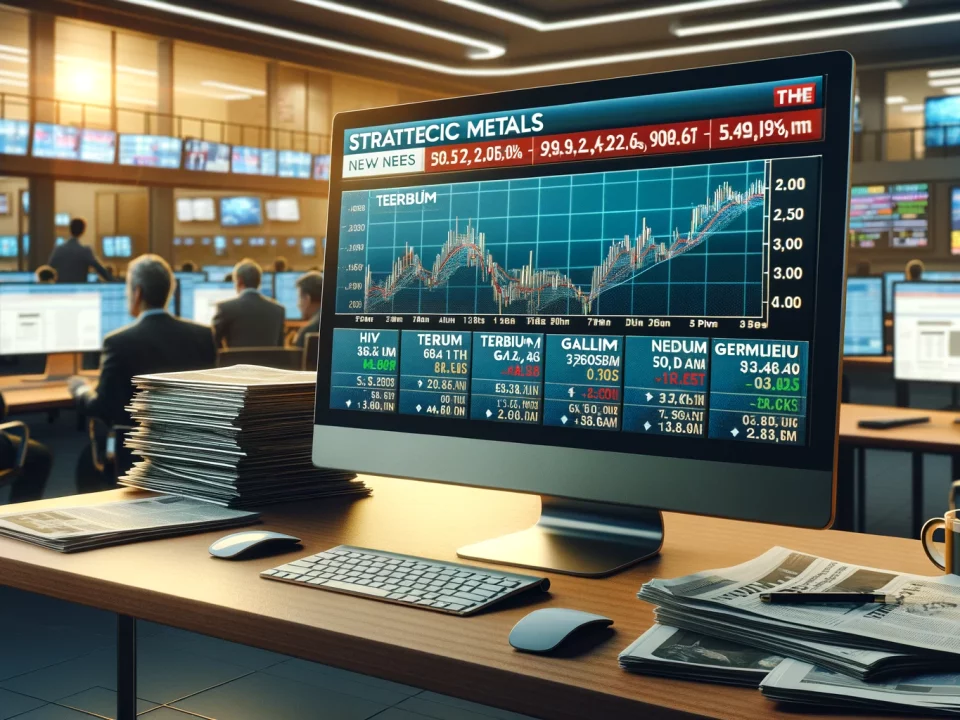
Weekly News Review March 31 – April 6 2025
April 6, 2025
China’s Rare‑Earth Clampdown
April 18, 2025Strategic Metals once again made waves in global politics this week. U.S. President Donald Trump outlined plans to revive the domestic coal industry, while resource-rich Uzbekistan secured multiple deals in the critical minerals sector with U.S. companies. Meanwhile, chemical company Solvay announced an expansion of its rare earth production at its French facility.
All this and more in our weekly round-up,
CHINA TIGHTENS EXPORT CONTROLS ON KEY RARE EARTH ELEMENTS:
The United States imposed import tariffs on various foreign goods in early April. The level of these tariffs varies depending on the trade deficit a given country maintains with the U.S. China, for example, faces a high tariff rate of 34 percent. The response from Beijing came swiftly: in addition to retaliatory tariffs, effective April 10, the Chinese government announced stricter export regulations on certain rare earth materials. From now on, the export of elements such as dysprosium, terbium, yttrium, gadolinium, samarium, lutetium, scandium, and their various compounds will require special government approval.
Why Are These Elements So Important?
Samarium is used in the form of samarium–cobalt (SaCo) magnets, which offer significantly better heat resistance than the more common neodymium–iron–boron (NdFeB) magnets. This property makes them the preferred choice for high-performance environments such as military technologies, where components must endure high temperatures and extreme operating conditions.
Scandium is primarily used in aluminum alloys. When added to aluminum, it drastically increases the material’s strength while maintaining its lightweight characteristics—making it highly valuable for aerospace applications and military technologies such as drones. It also plays a role in some types of fuel cells.
Yttrium is essential in various advanced technologies. In medicine, it’s used in specialized laser treatments. It is also a key component in LED manufacturing and is widely employed in laser technology.
Gadolinium has become indispensable in medical imaging, particularly as a contrast agent in MRI scans. Thanks to its unique paramagnetic properties, few viable alternatives exist. Gadolinium is also used in nuclear reactors as an effective neutron absorber.
Lutetium plays a central role in modern nuclear medicine, especially in positron emission tomography (PET), where it’s used as lutetium orthosilicate. Beyond medical applications, it is also used in LED technologies.
Dysprosium and Terbium have overlapping applications. Both are important in semiconductor and LED production. However, their most critical use is in permanent magnets. Standard NdFeB magnets begin to lose their magnetism at around 80°C. However, when doped with terbium or dysprosium, these magnets can withstand much higher temperatures, making them suitable for high-performance applications such as electric motors and aerospace components.
What Are the Potential Consequences?
It’s important to note that this is not an outright export ban but rather a regulatory tightening justified by China on national security grounds. Nonetheless, it grants Beijing the ability to withhold materials at its discretion. The full impact of this policy will only become evident in the coming months once updated export data is available.
A precedent can be found in China’s 2023 export restrictions on gallium and germanium, which led to a near-complete halt in foreign shipments shortly after their introduction. Other raw materials subject to new tariffs have seen more modest disruptions.
Another key factor affecting the global rare earth supply is the evolving situation in Myanmar. The country supplies significant raw materials for China’s rare earth industry, but exports have dropped sharply since mid-2024. The ongoing conflict between the military junta and rebel groups has directly impacted significant mining areas, and it remains unclear whether any production is currently taking place. According to recent reports by Reuters, some materials from rebel-held regions may soon re-enter the market. However, this is believed to involve existing stockpiles—exports that may also be subject to additional duties.
PAKISTAN STRATEGIC METALS ATTRACT US ATTENTION:
Talks between foreign ministers; U.S. delegation attends resource forum.
The United States recently announced new tariffs on foreign goods, set to take effect on April 9, based on each country’s trade deficit with Washington. Pakistan is among the most brutal hit, facing a steep 29 percent surcharge. Nevertheless, both countries are currently exploring ways to strengthen their bilateral cooperation. In addition to security policy, critical raw materials were also on the agenda during a recent meeting between U.S. Secretary of State Marco Rubio and Pakistan’s Foreign Minister Ishaq Dar.
Pakistan has vast mineral wealth, estimated to be worth six trillion dollars. Many of these resources remain underexplored, including not only copper and gold deposits but also potential reserves of rare earth elements and lithium. Key challenges include outdated infrastructure, a lack of reliable geological data, and low investor confidence—both domestic and international—due to inconsistent mining policies.
With the launch of the Pakistan Minerals Investment Forum this Tuesday, the country aims to position itself as an attractive investment destination. A U.S. delegation is expected to attend the event in Islamabad. Eric Meyer, a Senior Official at the Bureau of South and Central Asian Affairs, will meet with high-ranking Pakistani officials to explore opportunities for American businesses in Pakistan.
FRANCE: SOLVAY EXPANDS RARE EARTH PRODUCTION –
A new production line will be created to support Europe’s magnet manufacturers.
Chemical company Solvay announced on Tuesday the commencement of commercial production of Neodymium-Praseodymium (NdPr) at its La Rochelle facility in France. NdPr is a crucial precursor for producing permanent magnets widely used in electric vehicles, wind turbines, and other high-tech applications. Previously, the La Rochelle plant primarily produced rare earth products for catalyst applications. In 2022, the company revealed plans to broaden the plant’s product range to include additional rare earth materials.
The move aligns with Europe’s goals under the Critical Raw Materials Act, which aims to boost domestic production, refining, and recycling of critical minerals. The company has estimated that by 2030, it could supply around 30 percent of Europe’s demand for NdPr and aims to source 30 percent of its raw materials locally (we reported). With this expansion, Solvay’s La Rochelle plant has become, according to the company, the largest facility outside of China capable of separating all rare earth materials.
The announcement comes just days after China, the global leader in rare earth production, imposed export restrictions on seven rare earth elements. Notably, Neodymium and Praseodymium have not been included in these restrictions so far.
UNITED STATES: TRUMP AIMS TO REVIVE US COAL INDUSTRY –
Fossil fuels over renewables: U.S. energy policy shift set to impact raw material demand – wind energy forecast slashed.
U.S. President Donald Trump continues to steer his administration toward a fossil-fuel-centric energy agenda. On Tuesday, he issued executive orders to revive the domestic coal industry. The directives include increasing the use of coal to meet the country’s growing energy needs and prioritizing coal mining on federal land. Several coal-fired power plants scheduled for decommissioning may now remain operational longer due to regulatory rollbacks. One of the orders seeks to override state-level climate and fossil fuel regulations, specifically targeting laws in New York, Vermont, and California.
According to the U.S. Energy Information Administration, coal accounted for just under 16% of the nation’s electricity generation in 2023—down from nearly 45% in 2010. The expansion of renewable energy largely drove this decline. However, Trump has consistently pushed back against this trend since taking office. Early in his term, he withdrew the U.S. from the Paris Climate Agreement and halted the issuance of new federal licenses for wind energy projects—both actions enacted through executive orders.
Wind Power Outlook Slashed by 40%:
In the wake of Trump’s latest decrees, market research firm Wood Mackenzie revised its five-year forecast for new U.S. wind projects downward by a dramatic 40%. The firm now expects only 45.1 gigawatts of new onshore and offshore wind capacity to be installed by 2029, down from a previously forecasted 75.8 gigawatts.
The Trump administration’s energy policy will also reshape demand for raw materials. As previously detailed in our in-depth analysis, the demand for rare earth elements used in wind turbines in the U.S. may decline. However, sectors such as defense—which are also resource-intensive—could offset some of this reduced demand. Trump’s recognition of the strategic importance of critical materials like rare earths and gallium is evident in his push to expand domestic production, regardless of their application in renewables.
UZBEKISTAN AND US SIGN STRATEGIC METALS AGREEMENT:
Deals span the entire value chain — from exploration to processing.
Earlier this week, a delegation from Uzbekistan held a series of meetings with U.S. business representatives, resulting in the signing of several agreements across the critical minerals value chain, according to a statement from the Uzbek government. The projects cover various stages, including the sector’s exploration, mining, processing, and other value-added activities. In addition to critical minerals, discussions also touched on opportunities in the tourism and food industries.
Also this week, U.S. Secretary of State Marco Rubio met with Uzbekistan’s Foreign Minister, Bakhtiyor Saidov, in Washington to discuss the broader strategic partnership between the two nations. Rubio highlighted the importance of cooperation in the critical minerals sector as a key component of strengthening bilateral ties.
Resource-Rich Central Asia Becoming Increasingly Relevant;
The Central Asian state of Uzbekistan, like its neighboring countries, is rich in natural resources. According to the U.S. Geological Survey, Uzbekistan is a leading producer of molybdenum, rhenium, and cadmium and also has a significant copper, silver, and zinc industry. Positioned as a potential alternative to industry leader China, Uzbekistan’s resource wealth prompted the U.S. to sign a memorandum of understanding with the country last year to strengthen cooperation in the sector (we reported). For 2025, Uzbekistan is targeting approximately $1 billion in investments in its mining and mineral industries.
Beyond the United States, other global players have also recognized Central Asia’s potential. Last week, Uzbekistan hosted the first EU–Central Asia summit, where both sides committed to strengthening cooperation. As part of the initiative, the European Union announced plans to invest roughly $13 billion (€12 billion) into key regional sectors.
RUTHENIUM COULD IMPROVE TREATMENT FOR SPINAL CORD INJURIES:
A newly developed biomaterial shows promising results in spinal cord regeneration.
Each year, an estimated 250,000 to 500,000 people suffer spinal cord injuries, according to the World Health Organization. These injuries, often caused by accidents, falls, or acts of violence, are among the leading causes of paralysis, alongside strokes. However, due to the complex structure of the spinal cord, treatment remains highly challenging. A biomaterial developed at China’s Sichuan University, based on the precious metal ruthenium, offers new hope.
“The spinal cord functions like a highly specialized information highway with countless nerve fibers in a confined space,” explains lead researcher Chong Cheng in Advanced Science News. When an injury occurs, nerve signal transmission is disrupted immediately, making repair difficult. Because nerve cells have limited regenerative capacity, the damage is often irreversible.
Combating Secondary Damage with Ruthenium-Based Material:
Beyond the initial injury, secondary damage further complicates recovery. Cheng explains that reactive oxygen species accumulate, damaging DNA and causing severe tissue degradation and inflammation. So far, no effective treatments exist to address these secondary effects, partly because slow nerve regeneration makes clinical studies costly and time-consuming.
Cheng and his team developed a composite material combining ruthenium, copper hydroxide, and collagen to tackle this challenge. This innovative biomaterial reduces inflammation and neutralizes excess reactive oxygen species, thereby protecting nerve cells. While other research groups have explored antioxidant molecules for spinal cord injury treatment, most approaches involve intravenous or direct injection into the injury site. Cheng’s team believes their method has advantages over natural antioxidants like the enzyme superoxide dismutase, offering more excellent stability and better biocompatibility.
Promising Laboratory and Animal Studies:
In laboratory tests and animal models, the ruthenium-based material outperformed other substances. It significantly reduced inflammation and nerve cell destruction while promoting tissue repair. Rats treated with the material demonstrated markedly improved mobility after 28 days compared to untreated animals.
Despite these promising results, the path to clinical application remains long. Cheng and his team’s next steps include addressing technical and regulatory challenges and exploring partnerships with biotech companies for potential commercialization.
Figure of the Week: – 1 – The U.S. defense industry accounts for a fraction (1%) of the country’s rare earth demand—yet this share is critical and irreplaceable.






